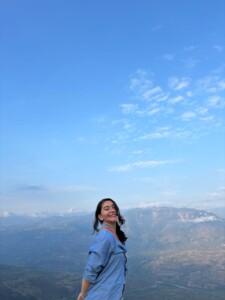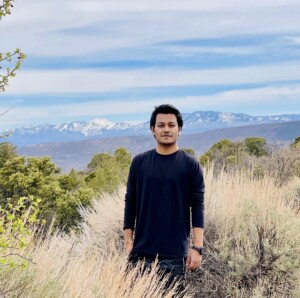Graduate Student Research
Graduate Student Research Links:
EES electronic theses and dissertations since 2020:
EES electronic theses and dissertations before 2020:
Graduate Student Research Spotlight
Maria Fernanda “Ferna” Alvarez-Carrascal, Ph.D. Candidate

Ferna’s research focuses on the intersection of natural resource management and decision-making processes that impact societal well-being. Her current work examines the influence of social indicators on communities’ access to safe drinking water in the United States, utilizing statistical modeling techniques. In addition to her research, she actively contributes to the Vanderbilt community as co-president of the Latin American and Caribbean Students Association and as a leader of Project Pyramid 2025. Her primary research interests include water accessibility, natural resource management, resource distribution, and data science.
Bryce Belanger, Ph.D. Candidate

Bryce’s research focuses on reconstructing past climate change using speleothems, which are mineral deposits that grow in caves over time. He uses geochemical techniques to better understand how precipitation changed during warm periods in earth’s past. Bryce has conducted field work in Wyoming, Kentucky, Tennessee, and the Philippines, and has focused specifically on reconstructing Holocene precipitation in the northern Rockies using two speleothems from Titan Cave, Wyoming. He also works to develop new geochemical recorders of past climate in speleothems using experimental techniques, most recently traveling to the University of Waikato in New Zealand to further investigate the “triple oxygen isotope” proxy in speleothems.
Alejandro Prieto, Ph.D. Student
Alejandro is a paleoecologist investigating the biogeographical patterns of mussels, from extant species to their first appearance in the fossil record approximately 425 million years ago. His research utilizes open-source databases, such as the Paleobiology Database, and tectonic plate reconstruction models to reconstruct mussel distributions through deep time. He is particularly interested in addressing macroevolutionary questions that challenge our understanding of patterns like the latitudinal diversity gradient and the spatial constraints imposed by specialization in certain mussel species. Alejandro’s research takes him to Germany, where he is affiliated with the Senckenberg Research Institute and Natural History Museum and collaborates with researchers at Friedrich-Alexander University of Erlangen-Nuremberg.
Mahir Tajwar, Ph.D. Student

Mahir’s research explores the biogeochemical and hydrological processes shaping freshwater ecosystems, emphasizing carbon cycling, artificial light pollution, and geochemical modeling. He investigates diel and seasonal variations in dissolved inorganic carbon (DIC), stable isotopes, and the dynamics of major cations, anions, and trace elements in Stephens Lake, Tennessee, a headwater lake underlain by carbonate bedrock. His work also examines the impact of Artificial Light at Night (ALAN) on aquatic metabolism using controlled ALAN stations to study shifts in primary productivity, respiration, and oxygen dynamics. Additionally, he investigates the interplay between sediment transport and nutrient cycling, with a focus on phosphorus dynamics across spatial scales in Stephens Lake. His research aims to understand how sediment-bound phosphorus is mobilized and recycled, influencing productivity and biogeochemical fluxes in oligotrophic freshwater systems. A recipient of the Gould Research Grant from the Geological Society of America (GSA), Mahir integrates field sampling, geochemical analysis, and nutrient transport modeling to advance understanding of freshwater ecosystem responses to environmental change.
Sarah Ward, Ph.D. Candidate

Sarah studies pores and crystals preserved volcanic pumice to better understand how and why volcanoes erupt. She’s currently analyzing pumice from the 2019 eruption of Volcano F, which is a submarine volcano located 200 meters underwater in the South Pacific (1000 km West of Fiji). She’s an avid user of Lawrence Berkeley National Lab’s Advanced Light Source, primarily utilizing X-Ray Tomographic techniques to quantify pumice pore structures in 3D. Her future work will focus on improving these techniques for analyses of pumice crystal content, particularly for samples from the Bishop and Young Toba Tuffs. She works with Professor Guilherme Gualda.
Hannah Wolf, Ph.D. Student

Hannah’s research studies windstorms in the Arctic, and use Bayesian statistical methods to use various meteorological parameters to estimate the probability of severe wind gusts. Using data collected from the ESRL lab in Utqiagvik, Alaska, she models the relationship between temperature, hourly mean wind speed, and bulk Richardson number with the number of minutes in the hour that exceed instantaneous wind speeds of 10 m/s, winds above which can cause damage to infrastructure and unsafe conditions for bowhead whale hunting. For her master’s thesis, she aims to create a multiple regression model and an interactions model to evaluate the probability of wind gusts above that threshold, and for her Ph.D. she aims to add a time series predictive model to estimate how the frequency and/or intensity of these windstorms might change over time as a result of rising temperatures in the Arctic. She works with Dr. Ralf Bennartz.
Aida Zyba, Ph.D. Student
 Aida’s research involves reconstructing past climate in the Western United States using geochemical methods and stalagmites—mineral formations that grow from the cave floor. She studies precipitation variability in coastal central California using two stalagmites from White Moon Cave, analyzing geochemical indicators to infer past climate patterns. Additionally, she complements traditional stalagmite geochemical analyses with novel geochemical signatures, such as fire markers, to assess the climate-fire relationship of a northern Wyoming cave system through above-ground and in-cave monitoring and sample collection following a controlled burn over the cave.
Aida’s research involves reconstructing past climate in the Western United States using geochemical methods and stalagmites—mineral formations that grow from the cave floor. She studies precipitation variability in coastal central California using two stalagmites from White Moon Cave, analyzing geochemical indicators to infer past climate patterns. Additionally, she complements traditional stalagmite geochemical analyses with novel geochemical signatures, such as fire markers, to assess the climate-fire relationship of a northern Wyoming cave system through above-ground and in-cave monitoring and sample collection following a controlled burn over the cave.

